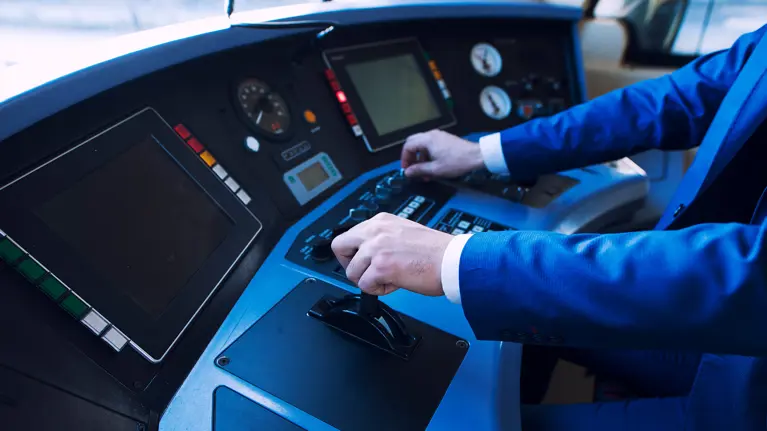
Advanced Simulations for a Defense Tech Company
Tietoevry Create helps Autocomp Management, an international software producer for defense sector, develop scalable & realistic road traffic simulation systems

Customer Manager, Tietoevry Create
Executive Summary
Goals: Autocomp Management aimed to engineer realistic, interactive, and flexible road traffic simulation systems for civil, emergency vehicles and defense training, while also optimizing the development costs and ensuring that these systems could be integrated with other software products and modules.
Solution: Developed two powerful, purpose-built software tools that helped to process and transform vast amounts of data and generate realistic 3D simulations populated by fully autonomous road users with their specific behavior.
Benefits: Created precise, stable, and risk-free road traffic simulation systems (that include the movement of emergency vehicles), which helped to meet the growing customer demands and strengthen the market position as a leading simulation software vendor.
Services delivered: Custom Development, Software R&D, QA and Testing
About the Client:
Autocomp Management is an international producer of hardware and software solutions tailored for the defence, uniformed services, and transportation industries. With a proprietary R&D center and a network of strategic partners across the globe, the company designs, patents, and engineers advanced automation software, training simulators, as well as wireless control systems.
- Industry: Defense & Software
- Location: Poland
- Size: 100+ employees
Business Challenge
One of the core business pillars of Autocomp Management involves the development of advanced training simulators for both civil and defense use.
To address the growing demand for interactive and realistic training systems, the company aimed to:
- Enhance the realism of the training – engineer systems that provide the most realistic simulated scenarios for both civil (transportation and emergency vehicles) and defense (battlefield, tactical operations) environments.
- Recreate specific environments – generate virtual replicas of real locations, while also reducing costs for training, especially with the use of vehicles and infrastructure.
- Facilitate the training process – enable effective, repeatable, and safe use of training simulations with the ability to generate special conditions and unusual events.
- Improve flexibility – the simulation systems had to be scalable and easily adaptable to the needs of the company’s customers.
However, creating such simulation systems is a challenging, time-consuming, and costly task, as it requires replicating thousands of kilometers of real terrain and road networks, including traffic signalizations and signs, intersections, and other objects.
Therefore, the key challenge was to build two powerful software tools that would:
- Process and virtualize vast amounts of data to create advanced road traffic simulation environments.
- Populate the simulations with autonomous road users (vehicles, pedestrians, and emergency vehicles), while also optimizing the development time and costs.
The first collaboration of Tietoevry with Autocomp Management started back in 2018 with a large-scale railway and truck training simulator. Since that time, we have won the client’s trust by proving to be a reliable and flexible IT provider that is able to quickly ramp up and scale a team. Furthermore, Tietoevry Create had the Qt/QML and C++ expertise required for this project, which is why Autocomp Management chose to partner with us yet again.
Solution & Business Value
Tietoevry Create developed two custom solutions tailored for the environment of Autocomp Management, which allowed to combine geographic input data with information from other sources and transform it into a simulated 3D world:
- Map Editor – a tool designed for importing geospatial data from both local and online sources, as well as visualizing, editing, and exporting it into different formats.
- Traffic Simulator – a solution that extends autonomous traffic simulations by adding new entities to them, such as pedestrians, trams, and emergency vehicles, along with their specific behavior.
The solutions helped Autocomp Management strengthen their position as the market-leading producer of advanced training simulation systems, providing a range of tangible benefits:
- Enhanced value proposition with modern tools that allow creating realistic simulation environments and meet the growing customer demands
- Better precision of simulations, which lowers the risks during civil or defese training, giving a competitive edge to the solutions of our client
- Optimized performance and better stability of simulation systems due to automated error detection and reporting
- A modular, scalable architecture that allows extending the functionality of simulation systems and seamlessly integrating them with other products and modules
- Significantly reduced development costs with rigorous, multi-stage software testing and a scalable team of engineers whose expertise was a perfect fit for this project
Satisfied with the outcomes and our partnership built on mutual trust, transparency, and commitment, Autocomp Management continues to cooperate with Tietoevry Create. Together, we work on advanced simulation software that has a profound impact on the efficiency of civil and defense training both in Poland and abroad.
Currently, we are collaborating on new functions for the simulation systems, including more sophisticated simulation scenarios with automated response to the user’s decisions (changes in the environment, weather, etc.)
Furthermore, as a part of our future plans with the client, we have discussed the probability of developing AI modules that simulate realistic behavior of road users, and integration with immersive AR/VR-based simulations for naval training and shipboard firefighting with full-scale ship models, as well as aircraft training.
Technical Details
Tietoevry Create provided a broad spectrum of services for Autocomp Management, ranging from technology consulting and requirements definition to architecture design and end-to-end development and testing of new simulation system components.
To help Autocomp Management build modern and scalable simulation software, we approached the development by dividing the project into numerous key modules, including:
- Configuration of vehicles (trucks, locomotives, etc.)
- Generation of autonomous traffic
- Development of typical and atypical road events with emergency vehicles
- Integration with input/output devices, such as control panels
- Creation of realistic user interfaces, including quick access functions and real-time parameters
- Modules to support the flexibility and scalability of the simulation systems
During the development of the Map Editor solution, an OpenStreetMap (OSM) raster data importer module was created to enable the further processing of the software source interface. In addition, our team created a National Marine Electronics Association (NMEA) data importer module to process the data from external sources and GPS-type devices, as well as a Web Map Service (WMS) data importer module for the source software. While working on these modules, our team also designed a neural network-based image feature matching algorithm for GPS and video datasets that allowed extracting signs, and types and positions of semaphores.
The Traffic Simulator solution was optimized for the Unity visualization engine, recently updated by our client. To facilitate the testing and debugging of the autonomous traffic in the simulations, our team developed a custom Graphical User Interface (GUI). This allowed us to configure various behavioral aspects of autonomous objects, such as the extent of vehicle congestion, while also creating triggers that generate traffic events.
Software testing was an integral part of the entire project, and took place on various levels, such as:
Developer testing and C++ code reviews – to detect errors during the early development stages and ensure the code works as expected
- Unit testing – automated tests to check the performance of the individual components of the source code
- Test automation – conducted on a continuous integration (CI) server to rapidly verify code changes and mitigate errors when new code was applied
- Automated UI testing – to validate the system’s functionality, look & feel, and interactions with the users
- Manual testing – done to ensure that the software functionality and quality meet the client’s requirements
Autocomp Management plans to continue cooperating with Tietoevry Create to extend their simulation systems with new features, as well as design and engineer other products, such as new simulation engines, device mockups, dynamics and logic for vehicles models, GUI functionality and more.
The primary scope of the planned products and development areas includes:
- Simulators for purpose-built vehicles (fire trucks, unmanned aerial vehicles, etc.)
- Command and operations management simulators used for defense training
- Networked training systems that involve multiple simulators used in a single scenario
- E-learning platforms that enable data and documentation gathering and management for educational centers
Technologies & Tools
- C++17 / C++20
- Qt5 with QtWidgets
- Qt6
- QML
- Conan
- Protocol Buffers
- CMake
- Docker
- Enterprise Architect
- PROJ
- PostgreSQL /w PostGIS
- OpenCV
- Adobe FBX SDK